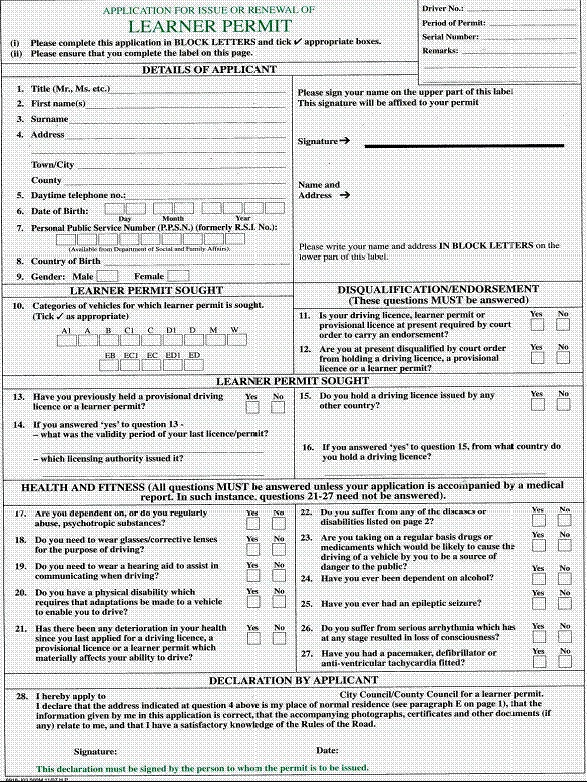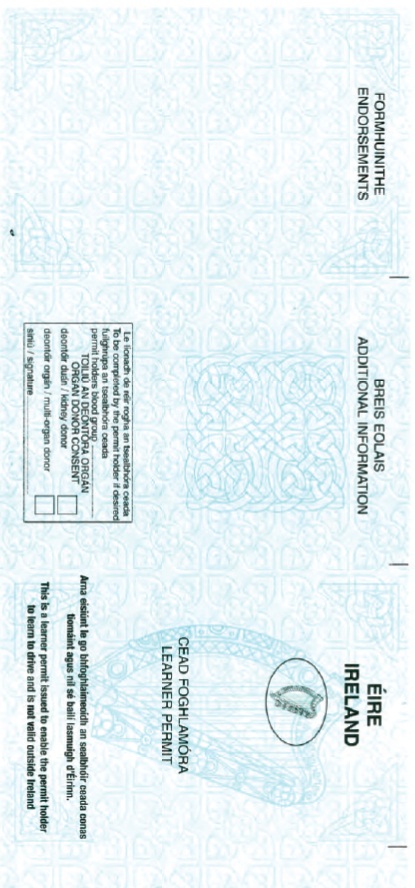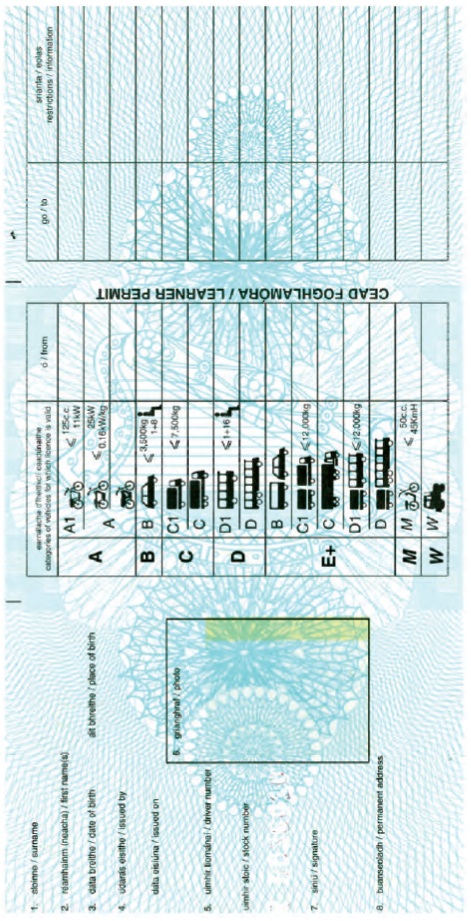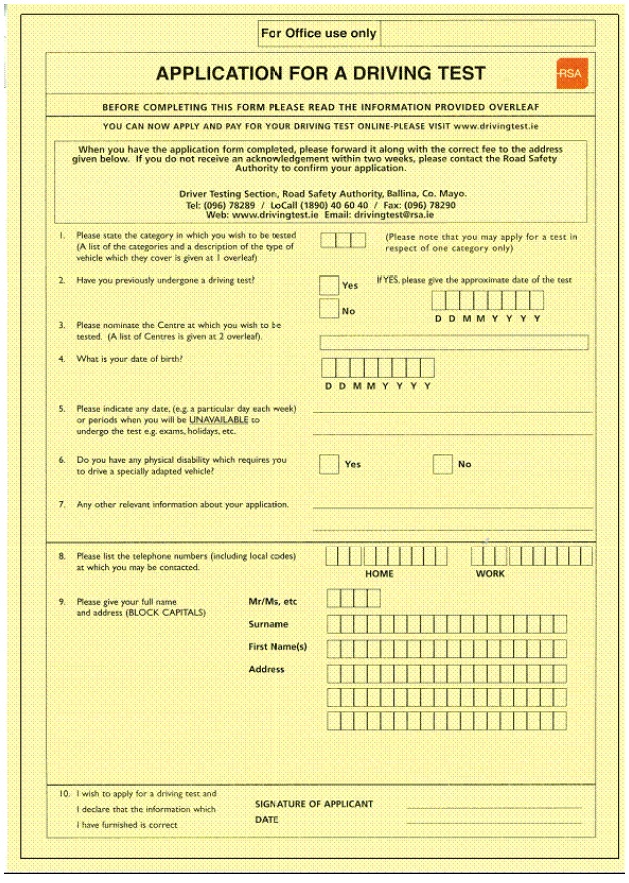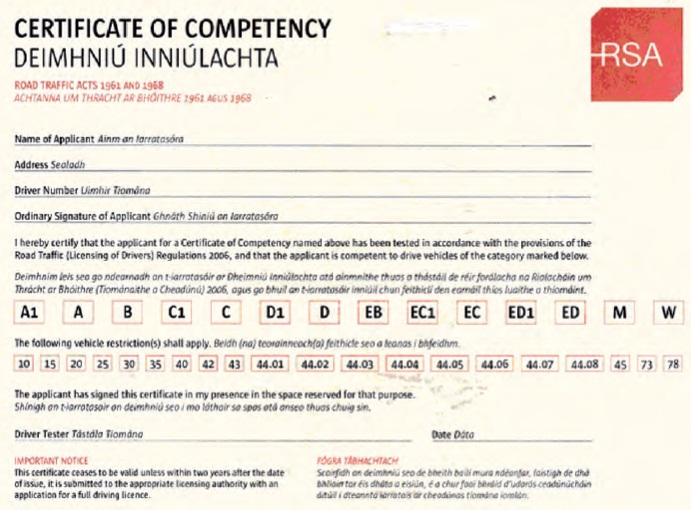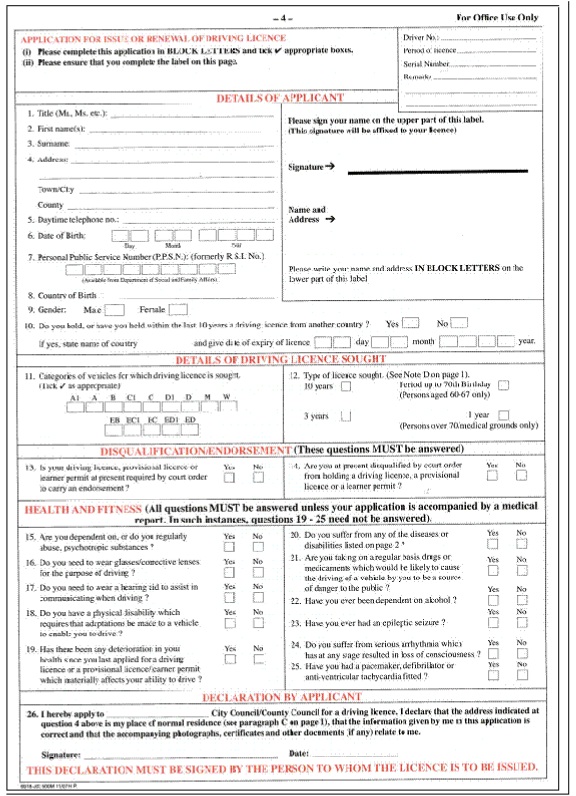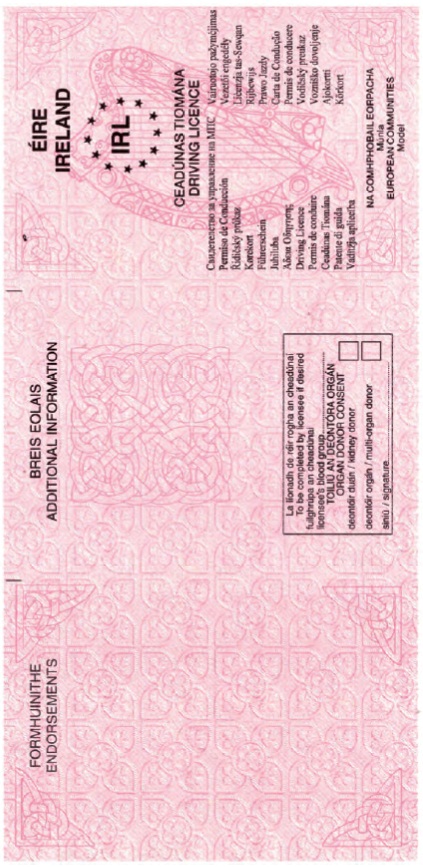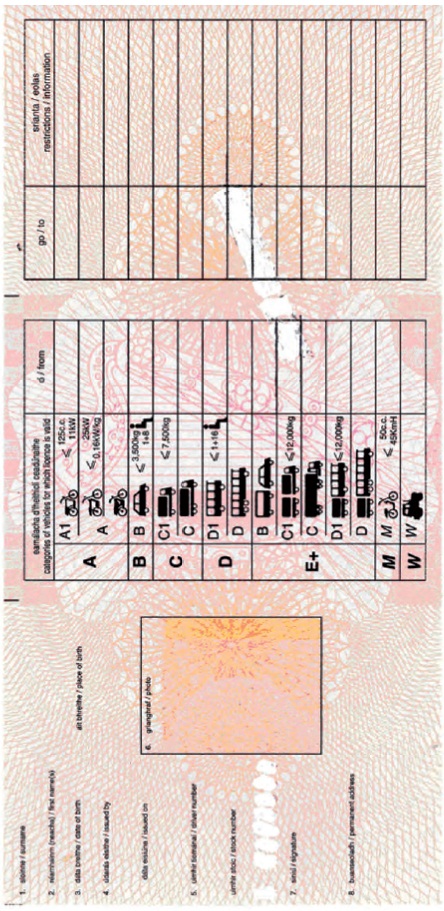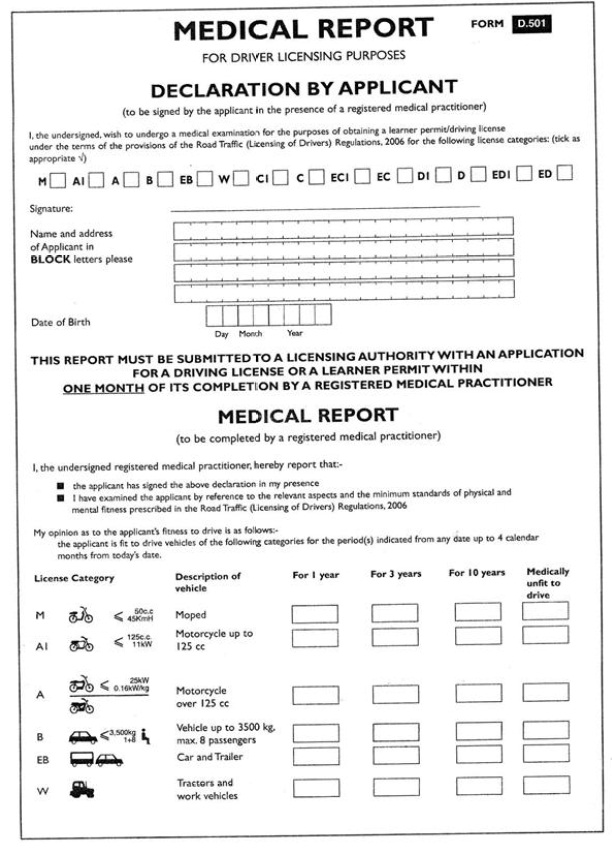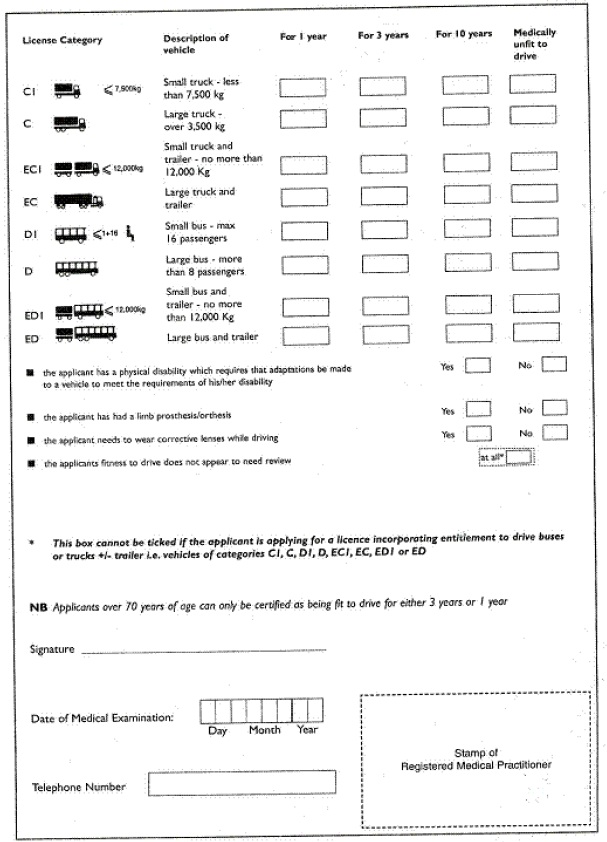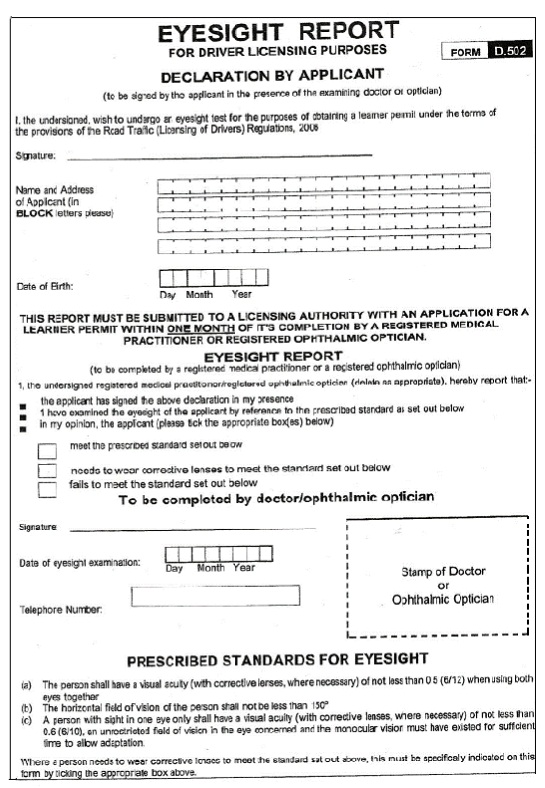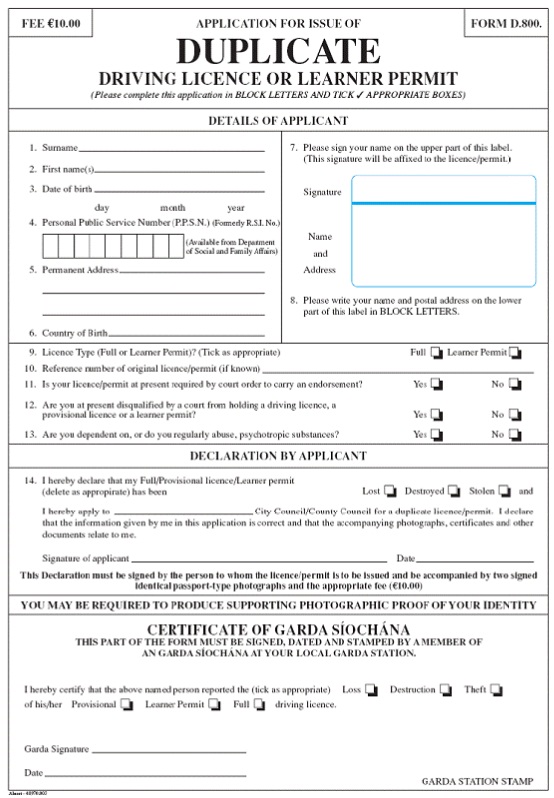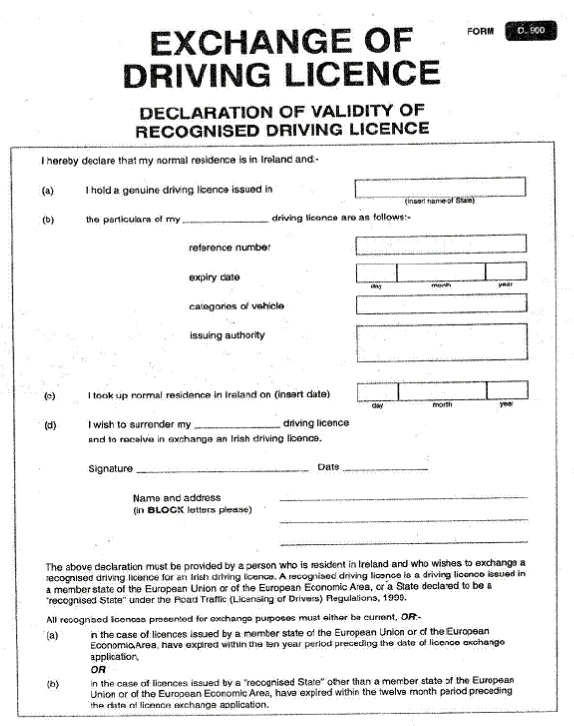S.I. No. 471/2008 - Road Traffic (Licensing of Drivers) (Amendment) Regulations 2008
Notice of the making of this Statutory Instrument was published in | ||||||||||||||||||||||||||||||||
“Iris Oifigiúil” of 25th November, 2008. | ||||||||||||||||||||||||||||||||
I, NOEL AHERN, Minister of State at the Department of Transport, in exercise of the powers conferred on me by section 42 (inserted by section 10 of the Road Traffic Act 2006 (No. 23 of 2006)) of the Road Traffic Act 1961 (No. 24 of 1961), section 2 of the Road Traffic Act 2006 (No. 23 of 2006), the National Roads and Road Traffic (Transfer of Departmental Administration and Ministerial Functions) Order 2002 ( S.I. No. 298 of 2002 ) (as adapted by the Public Enterprise (Alteration of Name of Department and Title of Minister) Order 2002 ( S.I. No. 305 of 2002 )), the Transport (Delegation of Ministerial Functions) (Road Traffic) Order 2008 ( S.I. No. 320 of 2008 ) and for the purpose of giving further effect to Council Directive No. 91/439 of 24 July 1991 1 , as amended by Commission Directive 2000/56/EC of 14 September 2000 2 and by Commission Directive 2008/65/EC of 27 June 2008 3 , hereby make the following regulations: | ||||||||||||||||||||||||||||||||
1. These Regulations may be cited as the Road Traffic (Licensing of Drivers) (Amendment) Regulations 2008. | ||||||||||||||||||||||||||||||||
2. The Road Traffic (Licensing of Drivers) Regulations 2006 ( S.I. No. 537 of 2006 ) are amended: | ||||||||||||||||||||||||||||||||
(a) in Regulation 3(1), by substituting for the definition of “automatic transmission” the following: | ||||||||||||||||||||||||||||||||
“ ‘automatic transmission’ means a vehicle in which no clutch pedal (or lever operated manually for categories A or A1 is present);”, | ||||||||||||||||||||||||||||||||
(b) in the Table to Regulation 32(1), by substituting for the matter at code reference 78 the following: | ||||||||||||||||||||||||||||||||
“Valid only for vehicles without a clutch pedal (or level operated manually for categories A or A1)”, | ||||||||||||||||||||||||||||||||
(c) by substituting for the heading to Regulation 42, the following: | ||||||||||||||||||||||||||||||||
“Definitions (Part 9).”, | ||||||||||||||||||||||||||||||||
(d) by substituting for the heading to Regulation 43, the following: | ||||||||||||||||||||||||||||||||
“Application of Part 9 to foreign driving licences.”, | ||||||||||||||||||||||||||||||||
(e) by substituting for Schedule 1 the Schedule set out in Part 1 of the Schedule, and | ||||||||||||||||||||||||||||||||
(f) by substituting for Schedules 4 and 5 the Schedules set out in Part 2 of the Schedule. | ||||||||||||||||||||||||||||||||
SCHEDULE | ||||||||||||||||||||||||||||||||
“ Part 1 | ||||||||||||||||||||||||||||||||
Regulation 3. | ||||||||||||||||||||||||||||||||
SCHEDULE 1 | ||||||||||||||||||||||||||||||||
Form D201 — Application for learner permit | ||||||||||||||||||||||||||||||||
| ||||||||||||||||||||||||||||||||
| ||||||||||||||||||||||||||||||||
Form D202 —learner permit | ||||||||||||||||||||||||||||||||
Side 1 | ||||||||||||||||||||||||||||||||
| ||||||||||||||||||||||||||||||||
| ||||||||||||||||||||||||||||||||
Side 2 | ||||||||||||||||||||||||||||||||
| ||||||||||||||||||||||||||||||||
| ||||||||||||||||||||||||||||||||
Form D301 — Application for a certificate of competency. | ||||||||||||||||||||||||||||||||
| ||||||||||||||||||||||||||||||||
| ||||||||||||||||||||||||||||||||
Form D.302 — Certificate of competency. | ||||||||||||||||||||||||||||||||
| ||||||||||||||||||||||||||||||||
| ||||||||||||||||||||||||||||||||
Form D401 — Application for a driving licence. | ||||||||||||||||||||||||||||||||
| ||||||||||||||||||||||||||||||||
| ||||||||||||||||||||||||||||||||
Form D402 — Driving licence. | ||||||||||||||||||||||||||||||||
Side 1. | ||||||||||||||||||||||||||||||||
| ||||||||||||||||||||||||||||||||
| ||||||||||||||||||||||||||||||||
Side 2 | ||||||||||||||||||||||||||||||||
| ||||||||||||||||||||||||||||||||
| ||||||||||||||||||||||||||||||||
Form D.501 — Medical report. | ||||||||||||||||||||||||||||||||
Side 1. | ||||||||||||||||||||||||||||||||
| ||||||||||||||||||||||||||||||||
| ||||||||||||||||||||||||||||||||
Side 2.Form. | ||||||||||||||||||||||||||||||||
| ||||||||||||||||||||||||||||||||
D502 — Eyesight Report. | ||||||||||||||||||||||||||||||||
| ||||||||||||||||||||||||||||||||
| ||||||||||||||||||||||||||||||||
Form D503 — Certificate of fitness. | ||||||||||||||||||||||||||||||||
| ||||||||||||||||||||||||||||||||
| ||||||||||||||||||||||||||||||||
AN tACHT UM THRACHT AR BHOITHRE, 1961 | ||||||||||||||||||||||||||||||||
ROAD TRAFFIC ACT, 1961 | ||||||||||||||||||||||||||||||||
Ainm an Iarratasora | ||||||||||||||||||||||||||||||||
Name of Applicant: | ||||||||||||||||||||||||||||||||
Seoladh | ||||||||||||||||||||||||||||||||
Address: | ||||||||||||||||||||||||||||||||
| ||||||||||||||||||||||||||||||||
| ||||||||||||||||||||||||||||||||
| ||||||||||||||||||||||||||||||||
Form D800-Application for duplicate driving licence or duplicate Learner Permit. | ||||||||||||||||||||||||||||||||
| ||||||||||||||||||||||||||||||||
| ||||||||||||||||||||||||||||||||
Form D.900 — Recognised driving licence declaration. | ||||||||||||||||||||||||||||||||
| ||||||||||||||||||||||||||||||||
| ||||||||||||||||||||||||||||||||
Part 2 | ||||||||||||||||||||||||||||||||
Regulation 26. | ||||||||||||||||||||||||||||||||
SCHEDULE 4 | ||||||||||||||||||||||||||||||||
Driving operations to be carried out during the practical driving test | ||||||||||||||||||||||||||||||||
(1) Skills and behaviour to be tested concerning categories A and A1— | ||||||||||||||||||||||||||||||||
(a) Preparation and technical check of the vehicle with a bearing on road safety. Applicants must demonstrate that they are capable of preparing to ride safely by satisfying the following requirements— | ||||||||||||||||||||||||||||||||
(i) Adjusting the protective outfit, such as gloves, boots, clothes and safety helmet, | ||||||||||||||||||||||||||||||||
(ii) Performing a random check on the condition of the tyres, brakes, steering, emergency stop switch (if applicable), chain, oil levels, lights, reflectors, direction indicators and audible warning device, | ||||||||||||||||||||||||||||||||
(iii) Putting the motorcycle on and off its stand and moving it, without the aid of the engine, by walking alongside the vehicle, | ||||||||||||||||||||||||||||||||
(iv) Parking the motorcycle, | ||||||||||||||||||||||||||||||||
(b) Behaviour in traffic. Applicants must perform all the following actions in normal traffic situations, in complete safety and taking all necessary precautions— | ||||||||||||||||||||||||||||||||
(i) Riding away: after parking, after a stop in traffic, exiting a driveway, | ||||||||||||||||||||||||||||||||
(ii) Riding on straight roads, passing oncoming vehicles, including in confined spaces, | ||||||||||||||||||||||||||||||||
(iii) Riding round bends, | ||||||||||||||||||||||||||||||||
(iv) Approaching and crossing of intersections and junctions, | ||||||||||||||||||||||||||||||||
(v) Changing direction, left and right turns, changing lanes, | ||||||||||||||||||||||||||||||||
(vi) Approach/exit of motorways or similar (if available), joining from the acceleration lane, leaving on the deceleration lane, | ||||||||||||||||||||||||||||||||
(vii) Overtaking/passing, overtaking other traffic (if possible), riding alongside obstacles, e.g. parked cars, being overtaken by other traffic (if appropriate), | ||||||||||||||||||||||||||||||||
(viii) Riding at the following (if available): roundabouts, railway level crossings, tram/bus stops, pedestrian crossings, riding up/downhill on long slopes, tunnels, | ||||||||||||||||||||||||||||||||
(ix) Taking the necessary precautions when getting off the vehicle. | ||||||||||||||||||||||||||||||||
(c) Applicants must perform the following special manoeuvres with a bearing on road safety— | ||||||||||||||||||||||||||||||||
(i) At least two manoeuvres to be executed at slow speed, including a slalom; | ||||||||||||||||||||||||||||||||
(ii) At least two manoeuvres to be executed at higher speed, of which one manoeuvre in second or third gear, at least 30 km/h and one manoeuvre avoiding an obstacle at a minimum speed of 50 km/h, | ||||||||||||||||||||||||||||||||
(iii) Braking: at least two braking exercises, including an emergency brake at a minimum speed of 50 km/h. | ||||||||||||||||||||||||||||||||
(2) Skills and behaviour to be tested concerning categories B, and EB. | ||||||||||||||||||||||||||||||||
(a) Preparation and technical check of the vehicle with a bearing on road safety. Applicants must demonstrate that they are capable of preparing to drive safely by satisfying the following requirements— | ||||||||||||||||||||||||||||||||
(i) Adjusting the seat as necessary to obtain a correct seated position, | ||||||||||||||||||||||||||||||||
(ii) Adjusting rear-view mirrors, seat belts and head restraints if available, | ||||||||||||||||||||||||||||||||
(iii) Checking that the doors are closed, | ||||||||||||||||||||||||||||||||
(iv) Performing a random check on the condition of the tyres, steering, brakes, fluids (e.g. engine oil, coolant, washer fluid), lights, reflectors, direction indicators and audible warning device, | ||||||||||||||||||||||||||||||||
(v) Checking the safety factors relating to vehicle loading: body, sheets, cargo doors, cabin locking, way of loading, securing load (category EB only), | ||||||||||||||||||||||||||||||||
(vi) Checking the coupling mechanism and the brake and electrical connections (category EB only), | ||||||||||||||||||||||||||||||||
(b) Special manoeuvres with a bearing on road safety. A selection of the following manoeuvres shall be tested (including one in reverse gear)— | ||||||||||||||||||||||||||||||||
(i) Reversing in a straight line or reversing right or left round a corner while keeping within the correct traffic lane, | ||||||||||||||||||||||||||||||||
(ii) Turning the vehicle to face the opposite way, using forward and reverse gears, | ||||||||||||||||||||||||||||||||
(iii) Parking the vehicle and leaving a parking space (parallel, oblique or right-angle, forwards or in reverse, on the flat, uphill or downhill), | ||||||||||||||||||||||||||||||||
(iv) Braking accurately to a stop, | ||||||||||||||||||||||||||||||||
(v) Coupling and uncoupling, or uncoupling and re-coupling a trailer from its motor vehicle; the manoeuvre must involve the towing vehicle being parked alongside the trailer (i.e. not in one line) (category EB only), | ||||||||||||||||||||||||||||||||
(vi) Reversing along a curve, (category EB only), | ||||||||||||||||||||||||||||||||
(vii) Parking safely for loading/unloading (category EB only), | ||||||||||||||||||||||||||||||||
(c) Test candidates must perform all the following actions in normal traffic situations, in complete safety and taking all necessary precautions— | ||||||||||||||||||||||||||||||||
(i) Driving away: after parking, after a stop in traffic; exiting a driveway, | ||||||||||||||||||||||||||||||||
(ii) Driving on straight roads; passing oncoming vehicles, including in confined spaces, | ||||||||||||||||||||||||||||||||
(iii) Driving round bends, | ||||||||||||||||||||||||||||||||
(iv) Approaching and crossing of intersections and junctions, | ||||||||||||||||||||||||||||||||
(v) Changing direction: left and right turns; changing lanes, | ||||||||||||||||||||||||||||||||
(vi) Approach/exit of motorways or similar (if available): joining from the acceleration leaving on the deceleration lane, | ||||||||||||||||||||||||||||||||
(vii) Overtaking/passing: overtaking other traffic (if possible), driving alongside obstacles, e.g. parked cars, being overtaken by other traffic (if appropriate), | ||||||||||||||||||||||||||||||||
(viii) Special road features (if available): roundabouts, railway level crossings, tram/bus stops, pedestrian crossings, driving up-/downhill on long slopes, tunnels, | ||||||||||||||||||||||||||||||||
(ix) Taking the necessary precautions when alighting from the vehicle. | ||||||||||||||||||||||||||||||||
(3) Skills and behaviour to be tested concerning categories C, EC, C1, EC1, D, ED, D1 and ED1. | ||||||||||||||||||||||||||||||||
(a) Preparation and technical check of the vehicle with a bearing on road safety. Applicants must demonstrate that they are capable of preparing to drive safely by satisfying the following requirements— | ||||||||||||||||||||||||||||||||
(i) Adjusting the seat as necessary to obtain a correct seated position, | ||||||||||||||||||||||||||||||||
(ii) Adjusting rear-view mirrors, seat belts and head restraints if available, | ||||||||||||||||||||||||||||||||
(iii) Random checks on the condition of the tyres, steering, brakes, lights, reflectors, direction indicators and audible warning device, | ||||||||||||||||||||||||||||||||
(iv) Checking the power-assisted braking and steering systems, checking the condition of the wheels, wheel nuts, mudguards, windscreen, windows and wipers, fluids (e.g. engine oil, coolant, washer fluid), | ||||||||||||||||||||||||||||||||
(v) Checking and using the instrument panel including the recording equipment, | ||||||||||||||||||||||||||||||||
(vi) Overtaking/passing: overtaking other traffic (if possible); riding alongside obstacles, e.g. parked cars; being overtaken by other traffic (if appropriate), | ||||||||||||||||||||||||||||||||
(vii) Checking the air pressure, air tanks and the suspension, | ||||||||||||||||||||||||||||||||
(viii) Checking the safety factors relating to vehicle loading: body, sheets, cargo doors, loading mechanism (if available), cabin locking (if available), way of loading, securing load (categories C, EC, C1, EC1 only), | ||||||||||||||||||||||||||||||||
(ix) Checking the coupling mechanism and the brake and electrical connections (categories EC, C1, ED, ED1 only), | ||||||||||||||||||||||||||||||||
(x) Being capable of taking special vehicle safety measures; controlling the body, service doors, emergency exits, first aid equipment, fire extinguishers and other safety equipment (categories D, ED, D1, ED1 only), | ||||||||||||||||||||||||||||||||
(xi) Reading a road map, route planning, including the use of electronic navigation systems, | ||||||||||||||||||||||||||||||||
(b) Special manoeuvres with a bearing on road safety. A selection of the following manoeuvres shall be tested (including one in reverse gear)— | ||||||||||||||||||||||||||||||||
(i) Coupling and uncoupling, or uncoupling and re-coupling a trailer from its motor vehicle; the manoeuvre must involve the towing vehicle being parked alongside the trailer (categories EC, EC1, ED, ED1 only), | ||||||||||||||||||||||||||||||||
(ii) Reversing along a curve, | ||||||||||||||||||||||||||||||||
(iii) Parking safely for loading/unloading at a loading ramp/platform or similar installation (categories C, EC, C1, EC1 only), | ||||||||||||||||||||||||||||||||
(iv) Parking to let passengers on or off the bus safely (categories D, ED, D1, ED1 only), | ||||||||||||||||||||||||||||||||
(c) Test candidates must perform all the following actions in normal traffic situations, in complete safety and taking all necessary precautions— | ||||||||||||||||||||||||||||||||
(i) Driving away: after parking, after a stop in traffic; exiting a driveway, | ||||||||||||||||||||||||||||||||
(ii) Driving on straight roads; passing oncoming vehicles, including in confined spaces, | ||||||||||||||||||||||||||||||||
(iii) Driving round bends, | ||||||||||||||||||||||||||||||||
(iv) Approaching and crossing of intersections and junctions, | ||||||||||||||||||||||||||||||||
(v) Changing direction: left and right turns; changing lanes, | ||||||||||||||||||||||||||||||||
(vi) Approach/exit of motorways or similar (if available), joining from the acceleration lane leaving on the deceleration lane, | ||||||||||||||||||||||||||||||||
(vii) Overtaking/passing: overtaking other traffic (if possible); driving alongside obstacles, e.g. parked cars; being overtaken by other traffic (if appropriate), | ||||||||||||||||||||||||||||||||
(viii) Special road features (if available): roundabouts, railway level crossings, tram/bus stops, pedestrian crossings, driving up-/downhill on long slopes, tunnels, | ||||||||||||||||||||||||||||||||
(ix) Taking the necessary precautions when alighting from the vehicle. | ||||||||||||||||||||||||||||||||
Regulation 26. | ||||||||||||||||||||||||||||||||
SCHEDULE 5 | ||||||||||||||||||||||||||||||||
Minimum vehicle requirements for the purposes of the practical driving test where the test vehicle was first registered on or after 1 January 2004 | ||||||||||||||||||||||||||||||||
| ||||||||||||||||||||||||||||||||
Minimum vehicle requirements for the purposes of the practical driving test where the test vehicle was first registered prior to 1 January 2004 | ||||||||||||||||||||||||||||||||
| ||||||||||||||||||||||||||||||||
” | ||||||||||||||||||||||||||||||||
| ||||||||||||||||||||||||||||||||
GIVEN under my hand, | ||||||||||||||||||||||||||||||||
19 November 2008 | ||||||||||||||||||||||||||||||||
NOEL AHERN, | ||||||||||||||||||||||||||||||||
Minister of State at the Department of Transport. | ||||||||||||||||||||||||||||||||
EXPLANATORY NOTE | ||||||||||||||||||||||||||||||||
(This note is not part of the Instrument and does not purport to be a legal interpretation.) | ||||||||||||||||||||||||||||||||
These regulations provide for certain changes relating to the conduct of driving tests and the forms, certificates and licences used in connection with driver testing and licensing. | ||||||||||||||||||||||||||||||||
1 OJ No L237, 24.08.1991, p. 1. |

